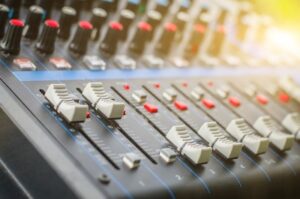How to Improve Sound Quality At Your Church
As a church, sound quality is paramount. Whether it’s music or preaching, the clarity and volume of your audio can make or break the atmosphere in your sanctuary. Unfortunately, many churches struggle to get their audio mixing just right for every service. Fortunately, there are some easy and cost-effective ways to improve the overall sound quality in your sanctuary.
So, what are some of the best ways to improve the sound quality in your sanctuary? Some of the best ways to improve the sound quality in your sanctuary include investing in quality microphones, using acoustic foam to reduce echoes, adding a sound absorber panel to the ceiling, upgrading your speakers, amplifying low frequencies with a subwoofer, and implementing digital mixing technology.
For cost-effective solutions, try double-checking your microphone placement and ensuring that all of the audio equipment is up to date and in working order.
In this post, we’ll discuss eight practical ways to improve the sound quality for your church sanctuary.

Eight Ways to Improve Sanctuary Sound Quality
Here are eight tips to help you get the most out of your church audio setup:
1. Invest in Quality Microphones
High-quality microphones can make a huge difference in the clarity of audio, particularly during live performances or sermons. You don’t need to invest in overly expensive mics, but you should invest in ones that will provide the best sound quality for your budget.
2. Use Acoustic Foam
Acoustic foam panels are an easy and cost-effective way to reduce echoes and reverberations in your sanctuary. They absorb sound waves, preventing them from bouncing off of walls and ceilings. You can also use acoustic foam panels to dampen low frequencies.
3. Add a Sound Absorber Panel to the Ceiling
Sound absorber panels placed on the ceiling can help reduce echoes and reverberations in your sanctuary. They also absorb low-frequency sound waves, ensuring that your audio is clear and balanced.
4. Upgrade Your Speakers
Speakers are an essential part of any church audio setup. A good set of speakers can make a huge difference in the overall sound quality of your sanctuary. Look for speakers that are designed to provide clear and balanced sound, even at higher volumes.
5. Amplify Low Frequencies with a Subwoofer
Subwoofers can help amplify low frequencies, providing a fuller and richer sound. This is especially important for churches with larger sanctuaries, where low-frequency sound waves can be lost in the mix.
6. Implement Digital Mixing Technology
Digital mixing technology, such as digital mixers or audio processors, can help you achieve a more balanced and accurate sound. It can also allow you to make quick adjustments on the fly, ensuring that your audio always sounds its best.
7. Double-Check Your Microphone Placement
It’s important to ensure that all of the microphones are placed correctly in order to achieve a clear and balanced sound. Make sure that mics aren’t too close or too far away from their intended source, as this can affect the overall sound quality.
8. Ensure That All Audio Equipment is Up to Date and In Working Order
It’s important to make sure that all of your audio equipment is up to date and in working order. This includes checking the cables and connections, making sure that all of the settings are correct, and ensuring that the sound levels are balanced.
These are just a few of the ways you can improve the sound quality in your church sanctuary. With a little bit of effort, you can ensure that your audio setup is up to par and that everyone in your congregation will be able to hear clearly during each service.

The Importance of Sound Quality for Your Church
Sound quality matters for any church, as it can have a major impact on the overall experience of your congregation. Poor sound quality can make it difficult to understand what’s being said or sung and can make sermons or performances feel flat or uninspired.
Good sound quality doesn’t have to be expensive; with the right equipment and some know-how, you can create a great-sounding sanctuary that your congregation will love.
Cost-Effective Ways to Improve Sanctuary Sound Quality
Improving sound quality doesn’t have to be expensive. If you are unsure how to improve your sanctuary’s sound quality on a budget, it can be helpful to consult with an audio specialist who can provide advice on the best cost-effective solutions for your unique needs.
In addition to any equipment upgrades, there are also some simple steps you can take to improve sound quality without breaking the bank.
For example, double-checking microphone placement and making sure all of the cables and connections are working correctly can make a big difference in the overall sound quality, without any additional equipment or costs.
Does Sound Quality Matter for a Church Sanctuary?
The answer is yes! Good sound quality is essential for churches of all sizes, as it can have a huge impact on the overall experience of your congregation. Poor sound quality can ruin sermons and performances, making it difficult for your congregation to understand what’s being said or sung.
Common Issues With Church Sound Quality
Poor sound quality is one of the most common issues faced by churches. This can be caused by a variety of factors, including outdated equipment, incorrect microphone placement, and improper sound levels.
It’s important to ensure that all of your audio equipment is up to date and in working order in order to avoid any common issues with church sound quality. Additionally, it can be beneficial to consult an audio specialist, who can help you identify the best cost-effective solutions for your unique needs.
By taking the time to ensure that your church sanctuary is equipped with the right audio setup, you can ensure that everyone in your congregation will be able to enjoy a clear and balanced sound during each service.
Training Volunteers to Use Your Church Sound System
Once you’ve got the sound quality in your church sanctuary sorted out, it’s important to make sure that all of your volunteers know how to use the equipment properly.
Training sessions can help ensure that everyone knows how to set up and operate the audio equipment correctly. This will save time and energy during each service, as well as ensure a smooth and seamless experience for your congregation.
Some of the things you should ensure that your volunteers know before letting them operate the equipment on their own include how to set up microphones and other audio equipment, how to balance sound levels, and what settings to use for each service.
New Sound Equipment vs. Used Sound Equipment for Your Church
When it comes to sound equipment for your church sanctuary, you have the option of either buying new or used items. New equipment is usually more reliable and will be able to offer higher-quality audio, however, it usually costs a lot more than used equipment.
Used equipment can often be found in good condition at lower prices, but it may not offer the same sound quality as new equipment. It’s important to do your research and determine which option is best for your church budget and needs before making a purchase.

In Conclusion
Good sound quality is essential for churches of all sizes and can have a huge impact on the overall experience of your congregation. With some effort and know-how, you can improve the sound quality in your church sanctuary without breaking the bank.
Consider implementing these eight simple steps to make sure that your church’s audio setup is up to par and that everyone in your congregation will be able to hear clearly and enjoy their time in the sanctuary. When it comes to church sound quality, a little bit of time and effort can go a long way!
Related Questions
How many microphones should your church own?
It depends on the size of your church, as well as the type of services and performances you have. Generally speaking, churches should have at least one microphone for each person who will be speaking or singing during a service.
Are handheld mics better than headset mics for church sound systems?
It depends on the type of service or performance. Handheld mics are usually better suited for spoken word and singing, while headset mics are best used by musicians who need to move around while playing.
What is equalization?
Equalization (or EQ) is the process of adjusting audio levels in order to achieve the desired sound. This process is typically done with a mixer or an equalizer, which allows you to adjust the frequency levels of each instrument or audio track in order to make them better blend together and create a balanced sound.
What type of audio equipment do I need for my church’s sanctuary?
The type of audio equipment that your church needs depends on the size of your sanctuary, as well as the type of services or performances you have.
Generally speaking, churches should have at least one microphone for each speaker, a mixer, and an amplifier to ensure good sound quality. You may also want to consider investing in additional audio equipment such as equalizers, monitors, and speakers.













